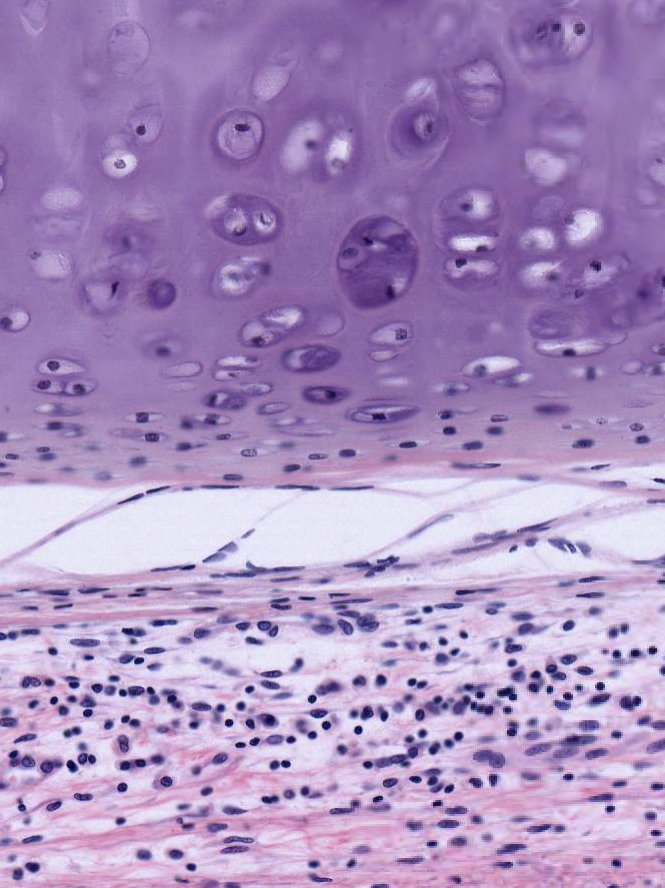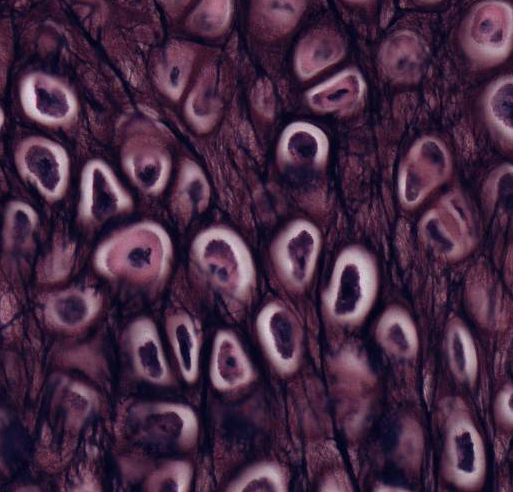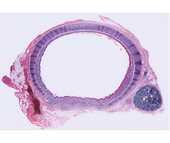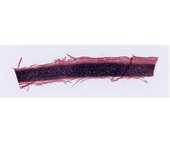Cartilage
Cartilage is a specialized type of connective tissue whose unique combination of rigidity, elasticity and resilience is due primarily to the special properties of its matrix. As in other connective tissues, its matrix is composed of fibers (collagenous or elastic) and a ground substance that is rich in extracellular glycosaminoglycans (particularly the chondroitin sulfates). Cartilage is avascular, but its matrix is permeable to nutrients and waste products.
Cartilage is the primary skeletal tissue of the fetus, and it serves as a model for the development of endochrondral bone. In the adult, cartilage forms the articular surfaces of joints, the skeleton of the external ear, the septum of the nose, supporting rings and plates of the trachea and bronchi, and intervertebral discs. Three types of cartilage are found in the adult: hyaline, elastic, and fibrocartilage. These are classified according to the predominant component of their extracellular matrix. As in other connective tissue classifications, there are gradations between these basic types.
Hyaline Cartilage
#5 Trachea (H&E)
 At low power, locate the incomplete rings of hyaline cartilage in the wall of the trachea. At higher magnification observe that a perichondrium surrounds the cartilage; this merges with the cartilage on one side and with the surrounding connective tissue of the other side. Blood vessels within the perichondrium provide the blood supply for the avascular cartilage. Chondroblasts are cells adjacent to the perichondrium and recently derived from it. They are not yet completely embedded in the matrix. Mature cartilage cells or chondrocytes are surrounded by matrix and lie within spaces called lacunae. In life the chondrocytes completely fill the lacunae. Note that the cartilage matrix is relatively homogeneous and basophilic. This is due to the masking of the collagen fibers by the high concentration of the glycosaminoglycans in the ground substance.
At low power, locate the incomplete rings of hyaline cartilage in the wall of the trachea. At higher magnification observe that a perichondrium surrounds the cartilage; this merges with the cartilage on one side and with the surrounding connective tissue of the other side. Blood vessels within the perichondrium provide the blood supply for the avascular cartilage. Chondroblasts are cells adjacent to the perichondrium and recently derived from it. They are not yet completely embedded in the matrix. Mature cartilage cells or chondrocytes are surrounded by matrix and lie within spaces called lacunae. In life the chondrocytes completely fill the lacunae. Note that the cartilage matrix is relatively homogeneous and basophilic. This is due to the masking of the collagen fibers by the high concentration of the glycosaminoglycans in the ground substance.
Elastic Cartilage
#6 External Ear (Elastic Stain)
 Elastic cartilage provides support with flexibility. The general organization of this type of cartilage is similar to that of hyaline cartilage, except that elastic fibers predominate over collagen fibers in the matrix. Elastic fibers are stained specifically (black) by the Weigert's stain. Where else does elastic cartilage occur in the body?
Elastic cartilage provides support with flexibility. The general organization of this type of cartilage is similar to that of hyaline cartilage, except that elastic fibers predominate over collagen fibers in the matrix. Elastic fibers are stained specifically (black) by the Weigert's stain. Where else does elastic cartilage occur in the body?
Fibrocartilage
Fibrocartilage can be considered as a transitional type of tissue, between hyaline cartilage and dense collagenous connective tissue, and it occurs in regions where support and great tensile strength are desirable.
Questions
1. What are the mechanisms of cartilage growth?
2.Are blood vessels found in cartilage and how does this relate to the nutrition of cartilage?

